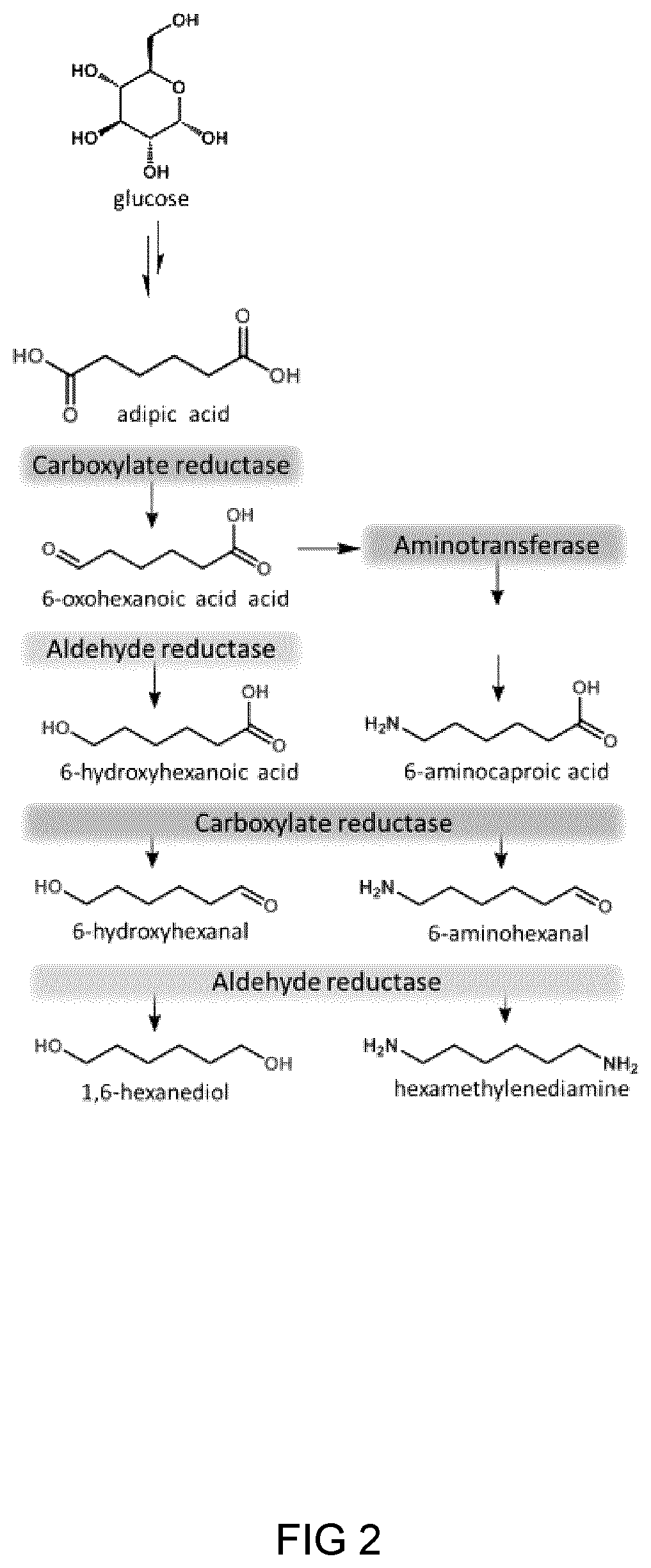Process and microorganism for synthesis of adipic acid from carboxylic acids
a technology of adipic acid and carboxylic acid, which is applied in the direction of biochemistry apparatus and processes, polypeptides with his-tags, enzymology, etc., can solve the problems of toxic by-products such as nitrous oxide produced by chemical processes
- Summary
- Abstract
- Description
- Claims
- Application Information
AI Technical Summary
Benefits of technology
Problems solved by technology
Method used
Image
Examples
example 1
Expression, and Purification of Proteins
[0173]Genes encoding the selected OYE and ERED proteins were PCR-amplified from genomic DNAs and cloned into p15Tv-Lic plasmid via a ligation-independent method as described in D. Bonsor, S. F. Butz, J. Solomons, S. Grant, I. J. S. Fairlamb, M. J. Fogg, G. Grogan, Organic and Biomolecular Chemistry 2006, 4, 1252-1260
[0174]Recombinant ERED plasmids were transformed into the E. coli BL21 (DE3) ΔiscR strain for the overexpression of iron-sulfur containing proteins (per methods described in M. K. Akhtar, P. R. Jones, Applied Microbiology and Biotechnology 2008, 78, 853-862). E. coli transformants were cultured aerobically at 37° C. in Terrific Broth (TB) medium (1 L) supplemented with 100 μg / mL ampicillin until the optical density (OD 600 nm) reached 0.6-0.8. At this point cultures were transferred to tightly-closed flasks with a magnetic stir bar and protein expression was induced with 0.4 mM IPTG after a 30 min-anaerobic pre-cultivation in the c...
example 3
reening: ERED Family (EC 1.3.1.31)
[0180]All results in this study are means from at least two independent determinations. Control experiments were performed in parallel to correct substrate-independent oxidation of cofactors and EREDs. All buffers and reagents used in anaerobic reactions were rigorously sparged with Ar to remove traces of oxygen before use.
[0181]The C═C reducing activity of EREDs was examined. Enzyme activity of purified EREDs was measured spectrophotometrically in 96-well plates by following incubation for 3-5 min at 30° C. in the anaerobic chamber as described in M. Bühler, H. Simon, Hoppe-Seyler's Zeitschrift fur Physiologische Chemie 1982, 363, 609-625. Buffers and reagents were degassed and sparged with Ar. Reaction mixture contained potassium phosphate (100 mM and pH 7.0), NADH (0.5 mM), indicated substrates, and proteins (0.1-50 μg) in a final volume of 200 μL. Enzyme reactions were monitored by following the decrease in absorbance at 340 nm (ε340 nm=6,220 / M·...
example 4
al Characterization of EREDCA and EREDBC
[0185]Anaerobic over-expression and affinity purification of six cloned EREDs produced significant amounts of soluble protein for EREDBC, EREDCA, and EREDCK (>5 mg / L), whereas the other three EREDs showed lower expression (FIG. 5). Purified EREDBC and EREDCA exhibited a brown colour in solution and an absorption spectrum with a shoulder at 380 nm and flavin-like maximum at 450 nm (FIG. 9). Both the brown colour of purified EREDBC and EREDCA and the 380 nm shoulder in its absorption spectrum suggest the presence of a functional [4Fe-4S] cluster. Our spectral studies revealed that purified EREDBC and EREDCA can be completely oxidized by oxygen (in the presence of air), reduced with an excess of NADH (3 mM), and then partially re-oxidized by substrate addition (i.e. 6 mM trans-cinnamic acid).
[0186]For in vitro biochemical characterization, enzyme activities of purified EREDs were measured with 2-hexenedioic acid, cis-cis-muconic acid, trans-trans...
PUM
| Property | Measurement | Unit |
|---|---|---|
| pH | aaaaa | aaaaa |
| temperatures | aaaaa | aaaaa |
| temperatures | aaaaa | aaaaa |
Abstract
Description
Claims
Application Information
 Login to View More
Login to View More - R&D
- Intellectual Property
- Life Sciences
- Materials
- Tech Scout
- Unparalleled Data Quality
- Higher Quality Content
- 60% Fewer Hallucinations
Browse by: Latest US Patents, China's latest patents, Technical Efficacy Thesaurus, Application Domain, Technology Topic, Popular Technical Reports.
© 2025 PatSnap. All rights reserved.Legal|Privacy policy|Modern Slavery Act Transparency Statement|Sitemap|About US| Contact US: help@patsnap.com



